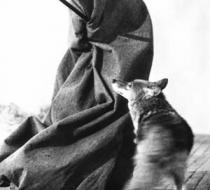Joseph Beuys, Coyote: I like America and America Likes Me, May 1974 Favorite
It was 1974 when Beuys arrived in New York City, ready to tackle a whole new challenge and create what was to become one of the most famous works of art of the time. Upon arrival, his assistants wrapped him in a large piece of felt and transported him, by ambulance, to the René Block Gallery in SoHo. There, awaiting the artist, was a live coyote. Beuys spent three consecutive days, eight hours at a time, locked up with the wild animal. He sat or stood, wrapped from head to toe in his large felt cover and held a crooked staff, peeking out from the top of the felt.
Props accompanying him in the cage included heaps of straw, a pile of copies of The Wall Street Journal of the day and a raggedy old hat from the best hat shop in London. Then, of course, there was his co-star, the coyote.
Beuys’ idea behind I Like America, and America Likes Me was to start a national dialogue. America in the 1970s, caught in the horrors of the Vietnam war, and divided by oppression of minorities, the indigenous population and immigrants, was far from the welcoming American Dream that the title of this performance suggests. The coyote symbolised a variety of things for Beuys:
First, there are some Native American myths that suggest that the coyote represents the possibility for transformation, as well as an archetypal trickster. Then, there are certain creation myths in which the coyote teaches human beings how to survive. And while most European settlers and their present-day American descendents generally regarded the coyote as an aggressive and dangerous predator, Beuys saw the animal as something completely different: to him, it was America’s spirit animal.
During the three days of the performance, Beuys attempted to make eye contact with the coyote, while performing symbolic gestures. He would toss his leather gloves at the animal, or wildly gesticulate at it. The coyote, in turn, was mostly curious, at times hostile, and often fairly calm. Once, he tore off a piece of Beuys’ gloves; another time, he tried to rip the felt cover off of Beuys, clenching it firmly in his jaws. But he also allowed Beuys to briefly embrace him. Beuys stayed in direct contact and communication with the coyote up until the very end of his performance. When it was over, he was bundled up again, returned to the ambulance, and driven straight back to the airport. He never once set foot on American soil, except for the gallery space. He wanted the only ground he touched in America to be the ground he shared with the coyote.
With this intense performance, Beuys wanted to demonstrate that American society could only start to heal its social issues through communication, connection and mutual understanding between all of America’s vastly different social groups.
Beuys’ performance with the coyote remains extremely relevant today, as America seems no closer to healing its deep wounds and closing the rifts between different social and ethnic groups. In fact, with white nationalism, fear-mongering, and racism towards minority groups prevalent not only across the United States, but also in Europe, Beuys’ profoundly moving communication with the wild coyote is a work of art that people can continue to learn from and seek answers and inspiration in. It appears that basic human and animal communication are in desperate need of a revival.







